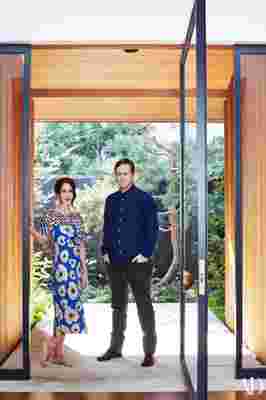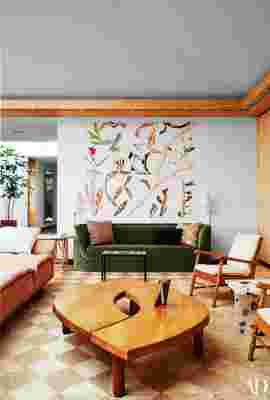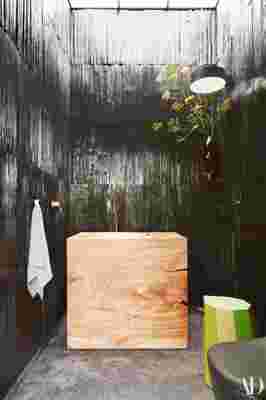When you’re a professional shelter-magazine writer, certain clichés come with the territory. There’s the house that’s modern but surprisingly warm; the house that blurs the boundaries between indoors and out; the house in which every object and design detail tells a story. The San Francisco home of Jessica and Aaron Sittig is all of the above—but there’s nothing clichéd about it.
“This was one of the most thoughtful and deliberate design processes we’ve ever been through. Aaron and Jessica wanted to drill down into every aspect of the project—conceptual, narrative, aesthetic, mechanical, and functional,” says Leo Marmol of Marmol Radziner , the Los Angeles–based AD100 architecture firm and restoration specialist tasked with the rehab of the Sittigs’ classic midcentury residence in San Francisco. His partner, Ron Radziner, seconds that emotion: “The level of rigor reminded me of the conversations we had when we were restoring Neutra’s Kaufmann House. We almost never get the opportunity to go this deep.”

Jessica and Aaron Sittig in the entryway.
Interior designer Charles de Lisle, who spent five years working in close collaboration with the homeowners and Marmol Radziner, is equally rhapsodic. “Jessica and Aaron approached the design process with a kind of intellectual curiosity beyond compare. We’d have eight-hour meetings about a door handle and hinges,” he recalls. “What makes them so extraordinary is that they don’t feel beholden to conventional wisdom about objects and rooms. They wanted to question everything.”
The Sittigs are a young power couple in the technology world, although they’d undoubtedly be mortified to find themselves described as such. They’d much rather be known, if at all, for their dedication to design, particularly as design development has always been part of their professional milieu. “We’re interested in how something great comes to be—whether it’s a perfectly placed tree, a piece of software, or a chair,” Jessica says.
We wanted to work with people we could have a conversation with.
Originally built in 1963, the Sittigs’ house is composed of stacked rectilinear volumes of redwood and glass, projecting from a steep San Francisco hillside. The taut modernist structure had barely been touched in the half-century since it arose in a neighborhood better known for Victorian and Beaux Arts finery. Its architect, Hank Schubart of Schubart and Friedman, apprenticed under Frank Lloyd Wright and worked in the studio of influential Bay Area maestro William Wurster.
In typically fastidious fashion, the Sittigs drew up a detailed spreadsheet of nearly 100 architects before ultimately alighting on Marmol Radziner. “We wanted to work with people we could have a conver-sation with—people deeply invested in research,” Aaron explains. A similarly exhaustive process led the couple to de Lisle, a San Francisco interior and product designer. “Charles is more chaotic and willing to improvise. We thought he’d be a good foil to the architects,” Jessica says.

A Betty Woodman wall-mounted ceramic sculpture overlooks a Pierre Chapo cocktail table.

The powder room features a hand-carved elm sink; black lacquered redwood paneling on walls.
Indeed, the extraordinary character of the home emerges from the tension between the meticulous architectural restoration and the wild panoply of decorative elements contained within. Deferring to the spirit of Schubart’s plans, the Sittigs and their design team essentially gutted and rebuilt the house, invisibly introducing necessary mechanical and seismic upgrades while replicating and refining its original design details.
Since many of the original off-the-rack hinges, knobs, and pulls went out of production decades ago—midcentury architects loved a good hardware store—the Sittigs had them remade. When a parti-cular architectural lighting fixture could not be procured, the couple went through the process of obtaining a UL listing for a custom version. “The stove top was our Waterloo,” Jessica laments, referring to a complex and as yet unresolved engineering challenge involving flush-mounted burners.
The homeowners’ fascination with craft and process naturally extended from humble hinges to the splashier furnishings and decorative flourishes that coalesce in de Lisle’s kaleidoscopic assemblage. For pure sex appeal (as design nerds would understand the phrase), it’s hard to beat the commodious living/dining room, with its panoramic view, massive retractable skylight, and huge glass sliders. Along one side of the room, panels of figured red birch veneer conceal a seriously seductive bar, bookshelves, and a small work station. Floating within the open expanse is an ever-changing landscape of toothsome vintage furnishings by the likes of Gio Ponti, Ward Bennett, Joe Colombo, Maurice Dufrène, and Pierre Chapo, all set atop a sprawling carpet of abaca tiles. A custom de Gournay wallpaper of pine trees in fog, as delicate as a Japanese ink drawing, lines the bar interior.
In addition to orchestrating this heady mix, de Lisle made his own contribution in the form of custom sofas that nod to both Northern California and Japanese craft traditions. De Lisle also served as a conduit between the Sittigs and the myriad designers, artists, and master craftsmen they enlisted to create custom pieces. Consider the bespoke dining table by Martino Gamper. De Lisle took his clients to London to meet the designer, and after more than a year and a half of conversations, sketches, and on-site mock-ups, Gamper fabricated a series of super-site-specific tables made of teak-banded Marmoleum set on powder-coated aubergine legs.
Max Lamb, another London-based design star, contributed a monolithic freestanding sink in the children’s bathroom. Cut from a solid block of Belgian bluestone, hand-finished, and embellished with an array of whimsical brass fixtures, the massive piece required plumbing to be rerouted and structural reinforcement of the floor.
Beyond boldface names on the international scene, the Sittigs engaged master artisans with deep ties to the California craft movement. In the stunning powder room off the kitchen, where the walls of rift-cut redwood are lacquered black in a nod to Japanese urushi, Rick Yoshimoto fashioned a hand-carved elm sink of de Lisle’s design that feels like a high altar in a pocket temple. Now based in New Mexico, Yoshimoto worked for years alongside California craft titan J. B. Blunk. The homeowners also commissioned designer Tripp Carpenter, son of the revered woodworker Arthur Espenet Carpenter, to create a desk for the Sittigs’ guest room, where de Lisle’s madcap strawberry pattern adorns the headboard, walls, and bed linens.
“Our joy comes from working with people we admire, giving them our story and the story of the house, and seeing what they come up with. It’s not about collecting,” Jessica says of the couple’s extraordinary design odyssey. Aaron puts a finer point on the process: “It was our job to care more than anyone else.”
